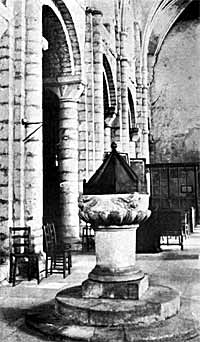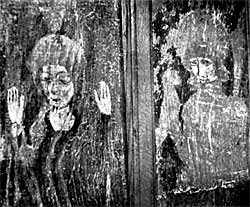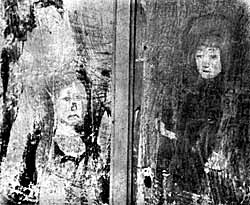
Church of St Mary and St Martin, Blyth. Interior of Nave showing Piers and Arcade, 1088. Font (17th century) and a portion of 13th-century Vault and 15th-century Screen.
There were disputes, mainly about tithes, between the prior and convent as rectors and their vicars, but at last these points were settled and enlarged accommodation for the parish was provided in the monastic church. The Early English south aisle was pulled down and the present Decorated aisle was built in its place about 1290. At the same time, the Early English porch was moved southward to allow for the increased width of the new aisle. This would be something of an undertaking, but such a removal was by no means unusual, for porches were extremely important parts of a parish church, and in addition to their religious uses they were of service for a variety of legal and other secular purposes. It seems likely that in order to bind themselves intimately to the parochial life of the township, the monks at this time surrendered such part of the church as now remains to the parish, reserving for themselves the transepts, the central tower and the eastern limb. To preserve their privacy they built the great wall with its curious door, now blocked, which closes the east end of the Norman nave. That this wall is of pre-Reformation date is proved by the wreck of a doom in fresco which can still be discerned upon its surface. The reason for this action on the part of the monks is to be found in the fact that the danger of their association with a French mother-house, which was little more than problematic in the reign of Richard I had become very great indeed by the time that Edward I had entered into his French wars. It is interesting to remember that Blyth church passed through this phase of its existence during the lifetime of Giotto, Cimabue and Dante.
The monastic bells which hung in the central tower would not be available for parochial use, and so, about 1400, the present tower was erected as a parish campanile.

Church of St Mary and St Martin, Blyth. Panel representing unidentified saints on Screen in Norman Nave.
It is a beautiful example of Perpendicular workmanship, and it is roughly contemporary with the battle of Agincourt. In order to make way for it, the two western bays of the nave were engaged, and in examining both it and outside of the church it is interesting to notice how the fashion for rectangular panels, which was so popular during the Perpendicular period, expresses itself in battlements which are merely architectural enrichments and have no military value. The Perpendicular window at the west end of the present nave also dates from this time.
The screens are of great interest. There is ample evidence that there were rood beams across the Norman nave and the Decorated south aisle, but these have disappeared. The present screens date from the 15th century, and their lower panels are adorned by figures of saints. These panels have been reset, and those in the screen in the Norman nave await identification, but in the Decorated aisle will be found, from north to south:—
St. Stephen, proto-martyr, bearing three great stones as his sign.
St. Euphemia, a saint much revered by the Greek Church as early as the 4th century. Because the flames to which she was condemned were extinguished by a miraculous shower, she was transfixed by a sword.
St. Edmund, king and martyr, bearing the arrows with which he was slain by the Danes about 870.
St. Helena, saint and empress, wife of Constantius Chlorus, and mother of Constantine the Great. She is believed, if tradition be true, to have visited Jerusalem in 326, and to have discovered the True Cross and the site of the Holy Sepulchre.
St. Barbara, protectress against tempests and sudden death. Her father, a zealous pagan, attempted to protect her against Christianity—and matrimony!!—by incarcerating her in a tower. She was converted by Origen, and after a series of unpleasant adventures was beheaded. She bears a tower as her emblem.
St. Ursula, saint and martyr, especially honoured at Cologne. Her story is that she was a princess of Brittany who was wooed by a British prince. She consented to marry him on condition that he should become a Christian and provide her with an escort of 10,000 virgin princesses for a three years’ pilgrimage to Rome. These terms were accepted, and accompanied by her entourage she sailed up the Rhine en route for the Eternal City. At Cologne she landed and accomplished the rest of her journey overland. On her return to Cologne she and her ladies fell into the hands of a horde of Huns by whom they were butchered.

Church of St Mary and St Martin, Blyth. Panel representing unidentified saints on Screen in Norman Nave.
The great interest of these paintings, which are comparable to the well-known picture of Queen Ediva in Canterbury Cathedral, is that they illustrate the position of English painting during the 15th century. While they were being executed, the Renaissance was at its height in Italy, and, roughly speaking, they are contemporary with the lifetime of such well-known artists as Fra Bartolomeo, Botticelli and Michelangelo himself.
To the west of the screen in the present nave stands a Jacobean pulpit, and the contrast between the design and execution of this pulpit and the 15th-century screen behind it is extremely interesting.
The font, decorated with amorini, dates from the 17th century. Probably the ancient font was removed or destroyed during the Commonwealth and this one was placed here after the Restoration, as its style would date it to about 1670.
Under the tower are preserved a collection of interesting relics, including a number of fragments of tombstones, some of which bear incised markings such as a sword and so forth. Incised markings are an early form of funerary recognition which developed into carvings in relief, like the magnificent foliaged cross of the 13th century, which is also preserved under the tower.
It is useful to contrast the calm dignity of the pose of the 13th-century figure on the Fitzwilliam tomb to the north of the altar, with the uncomfortable, naturalistic attitude of Edward Mellish’s figure in the north aisle, which dates from 1703. The Hellish swan upon a flanched shield is prominent about the church, particularly upon many of the interesting hatchments to be found at the west end of the north aisle.
The Fitzwilliam figure1 is extremely interesting and almost unique, because it is shown as wearing a heaume, or flat-topped helmet. Heaumes are fairly common on seals but rare in effigies. They were a type of helmet fashionable during the reign of Richard I, and they only remained in use for about fifty years, so that this figure must date between 1190 and 1240.
The charge on the shield is lozengy, probably the Fitzwilliam arms, lozengy argent and gules.
(For a further account of Blyth and Blyth Church see Thoroton Transactions, 1901, p. 27, and supplement p. 45.)
